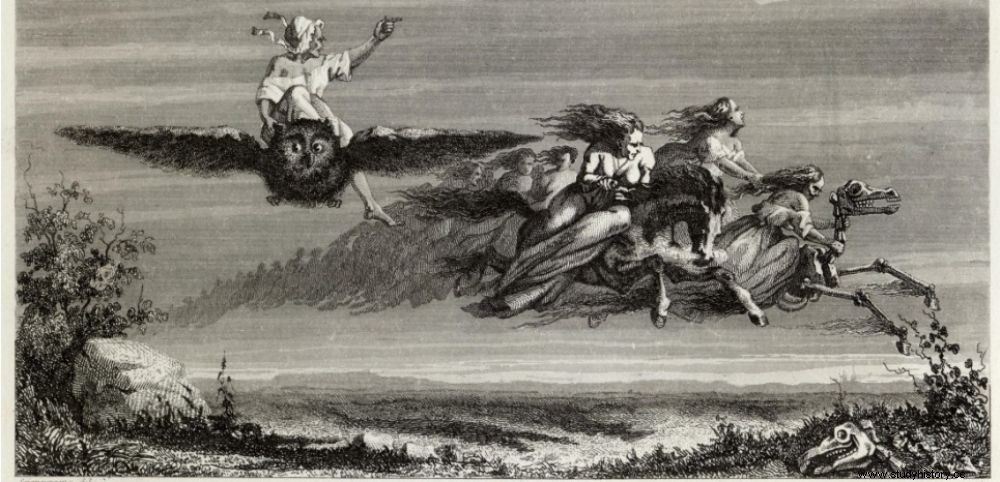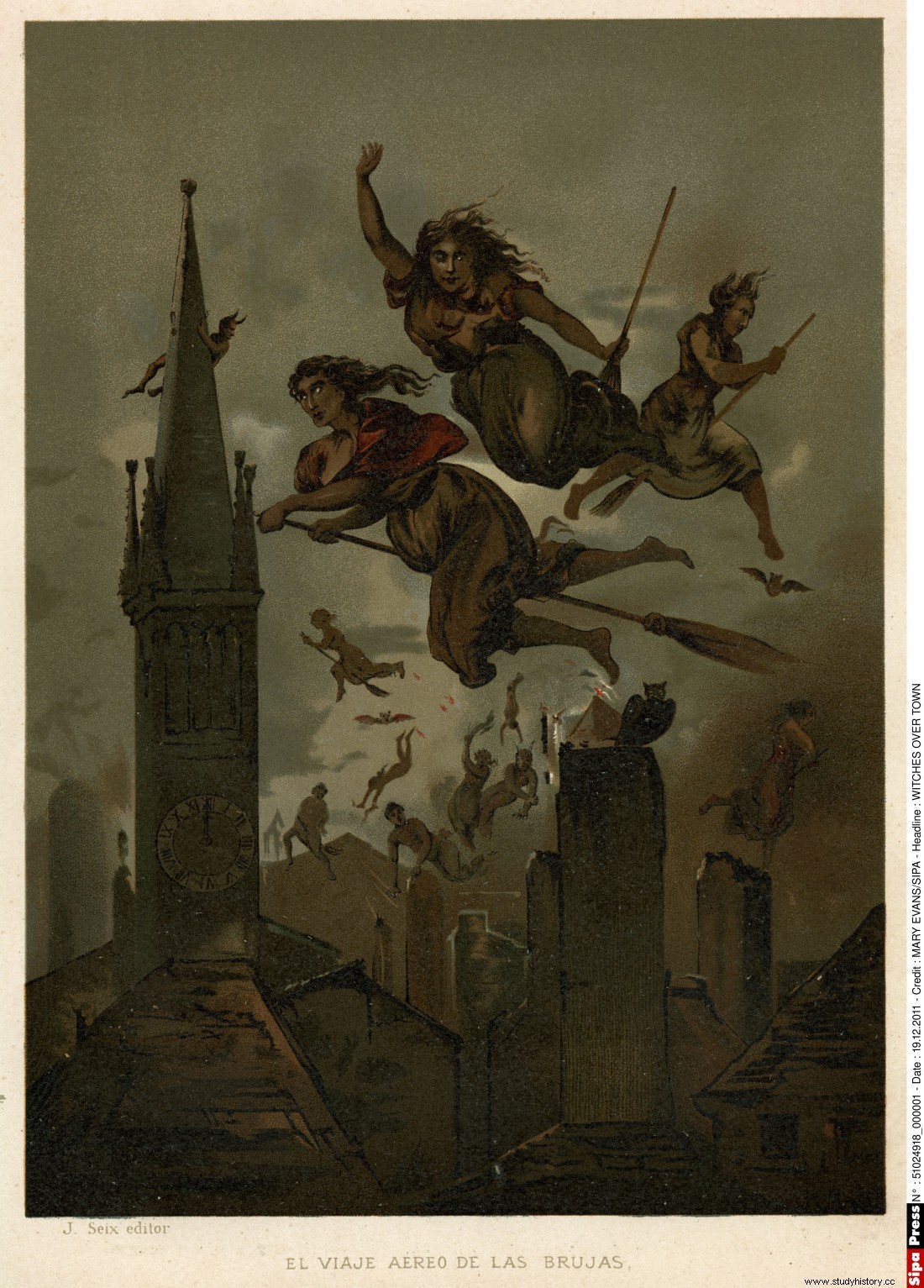 Witches Flying to a Sabbath (19th century engraving). Before being depicted on broomsticks, the "sortiaria" straddled animals, usually goats.
Witches Flying to a Sabbath (19th century engraving). Before being depicted on broomsticks, the "sortiaria" straddled animals, usually goats. PUMPKINS. In these Halloween times, a distant legacy of ancient pagan festivals, witches no longer ride their brooms... and pumpkins turn into lanterns:Harry Potter has been there! But what do we know today about these creatures that appeared in the Middle Ages - mainly women - who were persecuted for centuries to the point of ending up at the stake?

Meeting with Maxime Perbellini, doctoral student at the Center for Historical Research of the School of Advanced Studies in Social Sciences (EHESS), in Paris, specialist in the representation of witches at the end of the Middle Ages.
When did we first speak of a "witch" in Europe?
There is a great debate on the origin and etymology of this word, but its first mention in French appears in the middle of the XI e century, in the Roman d'Éneas (1060). Before the year 1000, under the Carolingians, these women, who manipulated herbs and who were suspected of bewitching, were described as herbariae , from sortiariae , fascinators, enchantresses, stryges or evil women. The lexicographic landscape of the witch is rich. In fact, from the Salic law of the Franks, around 500, until Charlemagne and various councils, there will be an amalgam between magic, witchcraft and paganism.
Why are witches depicted riding broomsticks?
 Image caption:XIX
th
engraving century depicting witches on broomsticks over a city. © MARY EVANS/SIPA
Image caption:XIX
th
engraving century depicting witches on broomsticks over a city. © MARY EVANS/SIPA
It is a great mystery, which always gives rise to bitter discussions! But these nocturnal rides, first on beasts—often goats—and later on broomsticks, were described as joining pagan powers. The first mention of these thefts is in the Corrector sive Medicus , written in 1095 by the German bishop Burchard of Worms. In a diary written around 1392, Le Ménagier de Paris , it is also written that women refuse to sleep with brooms in their rooms, for fear that they will be taken for witches. This woman who flies away for the Sabbath is only one face of the witch.
What is the Sabbath?
Here too, the notion of the Sabbath is a historiographical debate. It is in the Alpine arc, and in particular in the canton of Vaud, in Switzerland, that the first sabbats will be discussed between 1430 and 1440. In the 15th th century, the adjective “Sabbath” designates “nocturnal meetings of wizards” who meet in the middle of the night, in deserted moors or forests to participate in ceremonies and ritual orgies.
What happened after the XIII e century for the Church to want to eradicate witchcraft?
In the middle of the 13 th century, the status of the sorcerer passed under the influence of the devil, giving rise to the notion of heretic:He who refuses the grace of God, offering his action to satan, will burn in the eternal fire of hell. This Factum hereticale was created by the Church under the impetus of various popes such as Clement V, or John XXII. And what until then was the prerogative of the bishops will pass, via a series of papal bulls, in the hands of the Inquisition. Wizards and witches are the targets of this hunt for heretics.
Do we have an idea of the number of victims of these “witch hunts”?
According to the chronology proposed by the American historian Richard Kieckhefer, there were 5 to 10 trials per year between 1300 and 1420 with witchcraft as the charge. Then we go to 40 trials per year until 1500. The trend will continue to increase:some 30,000 trials will lead to a very high rate of death sentences between the XVI th and the 17 th century, notably in the Holy Empire, France and Switzerland (see box).
When did the first pyres date from?
Around 730, the Lex Alamannorum recounts the conviction of people who allegedly threw striae or herbariae (witches or herbalists) in the flames. Similarly, in 789 a cartulary of Charlemagne stipulates that it is forbidden to burn or devour the corpse of people accused of being witches, etc. All these mentions are very early. The last witch burned will be Anna Gödlin, executed in Switzerland in June 1782.
And for France?
In 1824, a woman accused of witchcraft was partially burned by peasants in the commune of Bournel (Lot-et-Garonne), while in 1856, another was thrown into an oven, in Camalès, in the Hautes-Pyrénées...
The figures for death sentences for witchcraft.
All of Europe embarked on a huge “witch hunt” from the twelfth
th
century, 70% to 80% of the accusations concern women, for whom in 60% of the cases the verdict was the stake! In Switzerland, 5,000 death sentences were handed down out of 8,000 trials between the 15th
th
and the 18
th
century. In the British Isles, there were 1500 and 2500 death sentences out of 5000 trials. In Scandinavia (Denmark, Norway, Sweden and Finland), between 1500 and 1800 victims out of 5000 trials. The lowest conviction rate is found in Southern Europe. Between 1580 and 1650, in Spain, out of 3500 trials, there would have been very few death sentences.
Find out more:
Claude Gauvard:The Fame of Being Witches:Four Women Accused of Witchcraft by the Provost of Paris in 1390-1391.
Jules Michelet:The Witch » (1862).
